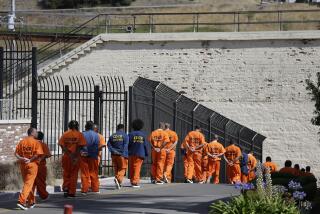California’s hidden hunger strike
Conditions in California prisons are so bad that a panel of federal judges ruled that they violate the U.S. Constitution’s prohibition on cruel and unusual punishment, but until recently the ensuing protests came mainly from lawyers rather than the inmates themselves. That changed on July 1, when thousands of inmates at one-third of the state’s prisons started a hunger strike.
A core group of at least 400 inmates in four prisons continues to refuse food, protesting the way the state treats prisoners deemed to be gang members. The strike began in the Special Housing Unit at Pelican Bay State Prison, where 1,100 inmates are isolated in soundproof cells for 22 1/2 hours a day. Their sole reprieve: one hour a day outside in a small area with high concrete walls.
Prison officials say this treatment is necessary to discourage membership in prison gangs, to obtain information on gang activity and to prevent “shot-calling” — the passing of orders from gang leaders to members in other prisons or out on the streets. Moreover, they say the hunger strike is being organized by gang leaders, and some strikers who would rather not participate are being coerced. Prisoner advocates, meanwhile, say such prolonged isolation leads to mental illness and is tantamount to torture.
So who’s right? We might have a better handle on that if prison officials weren’t refusing requests by The Times to interview striking inmates. Oscar Hidalgo, spokesman for the state Department of Corrections and Rehabilitation, told Times staff writer Jack Dolan that media weren’t being allowed into Pelican Bay “due to security and safety issues.” We’d be more inclined to believe that, and not that prison officials were trying to avoid adverse publicity, if California’s prisons didn’t have such an extraordinary history of shoddy medical care and inhumane conditions. As it is, we think the public has a right to firsthand accounts of what goes on behind the barbed wire.
Isolating inmates might indeed be appropriate to prevent shot-calling; then again, that problem would probably be better solved by stopping the widespread smuggling of cellphones into state prisons. Isolation might also be good for temporary punishment, but it’s not clear that such treatment is temporary. Hidalgo says one way to obtain release from the Special Housing Unit is to refrain from gang activity for six years — a remarkably long time to keep someone in solitary confinement simply for being a gang member.
But we’d rather not second-guess corrections procedures. It’s hard to assess the rightness or wrongness of the hunger strikers without access to them, and until officials provide it, they’re doing a disservice not just to inmates but to the people of California.
More to Read
A cure for the common opinion
Get thought-provoking perspectives with our weekly newsletter.
You may occasionally receive promotional content from the Los Angeles Times.





